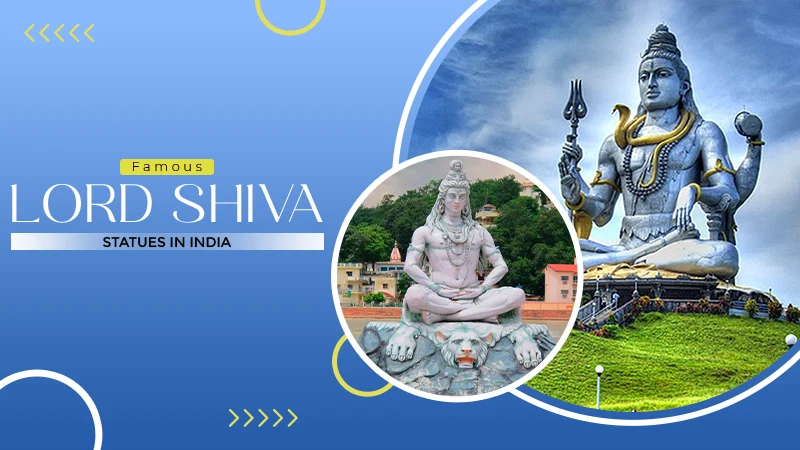
- 1. Murudeshwar Shiva Statue, Karnataka
- 2. Kailashnath Mahadev Statue, Sikkim
- 3. Bhimashankar Jyotirlinga Shiva Statue, Maharashtra
- 4. Rishikesh Shiva Statue, Uttarakhand
- 5. Kotilingeshwara Shiva Statue, Karnataka
- 6. Chandika Shiva Statue, Odisha
- 7. Haridwar Shiva Statue, Uttarakhand
- 8. Shiv Smarak, Pune, Maharashtra
- 9. Parvati Hill Shiva Statue, Maharashtra
- 10. Shiva Murti at Ambaji, Gujarat
- Tips for Visiting Lord Shiva Statues in India
- Conclusion
India is a land of spirituality, stories, and incredible artistry, and no deity captures the hearts of millions quite like Lord Shiva, the Mahadev, the eternal yogi. Everywhere you go, from bustling cities to serene mountain valleys, you’ll find magnificent Shiva statues that radiate devotion, peace, and timeless energy.
Each of these Lord Shiva Statues has its own story to tell; some rise majestically by the sea, while others overlook lush forests or snow-capped peaks. Visiting these statues is more than just sightseeing; it’s about feeling the calm, soaking in the spiritual vibes, and connecting with centuries of devotion carved in stone. If you’re inspired and want to bring a piece of this divine energy home, you can explore a beautiful collection of Lord Shiva Statues that carry the blessings of Mahadev.
Whether on a pilgrimage or just exploring, these Lord Shiva Statues offer an unforgettable experience. Here are the Top 10 you must see in India.
1. Murudeshwar Shiva Statue, Karnataka
Standing tall at around 123 feet, the Murudeshwar Shiva Statue in Karnataka is one of the tallest Lord Shiva statues in the world. Located on the coast of the Arabian Sea, this breathtaking idol overlooks the water, creating a divine view of faith meeting nature. The statue is part of the Murudeshwar Temple complex and shows Lord Shiva in a meditative posture.
At sunset, when the golden light hits the statue, it looks almost ethereal. Devotees visit not only for spiritual peace but also to witness one of India’s most stunning coastal temple views.
Best time to visit: November to February
Highlight: The statue glows beautifully during the evening, reflecting on the sea.
2. Kailashnath Mahadev Statue, Sikkim
Located in the mighty Himalayas, the Kailashnath Mahadev Statue in Sikkim stands as a magnificent symbol of devotion. Built at a height of 143 feet, it overlooks the breathtaking Teesta River Valley. The statue’s calm expression captures the stillness of the surrounding landscape.
Apart from being a spiritual destination, it’s a paradise for photographers and travelers who love combining nature and faith. The snow-covered peaks in the background make the statue appear divine beyond words.
Best time to visit: March to June
Highlight: Stunning Himalayan backdrop and peaceful surroundings.
3. Bhimashankar Jyotirlinga Shiva Statue, Maharashtra
The Bhimashankar Temple is one of the twelve Jyotirlingas in India, and its Shiva statue adds profound spiritual energy to the place. Located in the Sahyadri Hills, this ancient temple complex features beautiful carvings and mythological sculptures.
The Shiva statue here is a perfect blend of ancient charm and spiritual power. Pilgrims from across India visit Bhimashankar during Maha Shivaratri to seek blessings and experience divine vibrations.
Best time to visit: October to February
Highlight: Lush green forest trails and beautiful trekking routes.
4. Rishikesh Shiva Statue, Uttarakhand
Rishikesh, known as the “Yoga Capital of the World,” is home to one of the most iconic Lord Shiva statues seated calmly on the banks of the Ganga River. The statue represents Shiva in deep meditation, surrounded by the soothing sound of flowing water and temple bells.
Every evening during the Ganga Aarti, the sight of this statue with glowing diyas and chanting mantras creates an atmosphere filled with peace and devotion.
Best time to visit: Throughout the year, especially during Shivratri
Highlight: Ganga Aarti viewed with the backdrop of Lord Shiva.
5. Kotilingeshwara Shiva Statue, Karnataka
As the name suggests, Kotilingeshwara Temple literally means “the place of a crore lingas.” The temple houses over 90 lakh Shiva Lingas of various sizes and a 108-foot-tall Shiva statue that dominates the landscape.
This unique temple is not just a pilgrimage spot but also a remarkable architectural achievement that draws both devotees and curious travelers alike.
Best time to visit: December to March
Highlight: Millions of Shiva Lingas are spread across acres of land.
6. Chandika Shiva Statue, Odisha
Odisha is home to many temples, but the Chandika Shiva Statue stands out for its traditional art and cultural essence. The detailed craftsmanship showcases the ancient sculpting techniques of Odisha, while the calm yet powerful expression of Shiva represents inner peace and spiritual strength.
This lesser-known yet profoundly sacred statue is perfect for those who prefer quieter, spiritually charged places away from tourist crowds.
Best time to visit: November to February
Highlight: Rich artistic detailing and peaceful atmosphere.
7. Haridwar Shiva Statue, Uttarakhand
Another beautiful sight of Lord Shiva can be found in Haridwar, one of India’s holiest cities. The 100-foot-tall Shiva statue stands near Har Ki Pauri Ghat, welcoming devotees entering the city. With the river Ganga flowing nearby, the location perfectly embodies purity, divinity, and faith.
During evening prayers, the soft glow of lamps reflecting off the statue makes it an unforgettable spiritual experience.
Best time to visit: October to April
Highlight: Har Ki Pauri Aarti with the Shiva statue in view.
8. Shiv Smarak, Pune, Maharashtra
The Shiv Smarak in Pune is not just a statue; it’s a landmark dedicated to Lord Shiva’s divine energy. Though still under construction, this massive structure is expected to be among the tallest Shiva statues in India once completed.
Situated on a lovely site overlooking Pune city, it will symbolize the eternal strength and power of Mahadev, blending modern engineering with divine inspiration.
Best time to visit: Year-round (after completion)
Highlight: A grand upcoming monument for devotees.
9. Parvati Hill Shiva Statue, Maharashtra
Located on the historic Parvati Hill in Pune, this Shiva statue offers a wide view of the city below. The temple complex surrounding the statue is centuries old, adding to its sacred atmosphere. Devotees often climb the hill to offer prayers and enjoy the peaceful surroundings.
It’s a blend of physical effort, spiritual fulfillment, and stunning natural views, a true experience of devotion and discipline.
Best time to visit: Early mornings or evenings
Highlight: Sunrise view from the temple hilltop.
10. Shiva Murti at Ambaji, Gujarat
Located near the sacred Ambaji Temple, the Shiva Murti in Gujarat is a magnificent creation symbolizing Lord Shiva’s cosmic power. Surrounded by mountains and greenery, it offers visitors a sense of calm and connection to nature.
This destination attracts both devotees and tourists seeking peace and divine blessings. The site also hosts annual fairs during Maha Shivratri, making it a lively spiritual hub.
Best time to visit: February to April
Highlight: Maha Shivratri celebrations and serene surroundings.
Tips for Visiting Lord Shiva Statues in India
- Dress modestly and respect local customs.
- Avoid peak hours for a more peaceful darshan.
- Carry water, light snacks, and a scarf (especially for temples requiring a head covering).
- Photography may be restricted in some temples; always ask before clicking.
- The best time to visit most Shiva temples is during Maha Shivratri, when the energy and devotion are at their peak.
Conclusion
Exploring these Top 10 Lord Shiva Statues in India, we’ve seen how each one is unique not just in size or location, but in the spiritual energy it radiates. From the towering Murudeshwar statue by the Arabian Sea to the serene Kailashnath Mahadev in Sikkim, and from historic hilltop idols in Pune to sacred Jyotirlingas like Bhimashankar, each statue tells a story of devotion, artistry, and faith.
These statues are more than landmarks; they offer a glimpse into centuries of culture, spiritual practices, and the timeless reverence for Mahadev. Visiting them is an opportunity to experience peace, connect with divine blessings, and witness the grandeur of India’s spiritual heritage.
Which is the tallest Lord Shiva statue in India?
The Kailashnath Mahadev Statue in Sikkim, standing at around 143 feet, is considered the tallest Lord Shiva statue in India, followed closely by the Murudeshwar Shiva Statue in Karnataka.
What is the best time to visit these Shiva statues?
While you can visit most Shiva temples and statues throughout the year, the period between February and March, especially during Maha Shivratri, offers the most divine and festive atmosphere.
Are these Shiva statues open to tourists of all faiths?
Yes, absolutely. These places are not just religious sites but also cultural and architectural marvels. People from all walks of life visit to experience their serenity and grandeur.
What should one keep in mind while visiting Shiva temples or statues?
Visitors should dress modestly, remove footwear before entering temple premises, avoid loud behavior, and seek permission before taking photos in restricted areas.
Which Lord Shiva statue offers the most scenic view?
The Murudeshwar Shiva Statue in Karnataka offers a breathtaking view of the Arabian Sea, especially at sunset, making it one of the most visually stunning Shiva statues in India.












